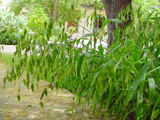Native Plants

Q. Who is Mr. Smarty Plants?
A: There are those who suspect Wildflower Center volunteers are the culpable and capable culprits. Yet, others think staff members play some, albeit small, role. You can torture us with your plant questions, but we will never reveal the Green Guru's secret identity.
Did you know you can access the Native Plant Information Network with your web-enabled smartphone?
Ask Mr. Smarty Plants is a free service provided by the staff and volunteers at the Lady Bird Johnson Wildflower Center.

rate this answer
Thursday - April 01, 2010
From: Austin, TX
Region: Southwest
Topic: Non-Natives
Title: Non-native, invasive bamboo for sloped river bank in Texas?
Answered by: Barbara Medford and Nan Hampton
QUESTION:
What type of native plants/trees/shrubs/grasses would you recommend planting on a 20 ft sloped bank on the Colorado river in Texas to prevent further erosion of the bank? How do you feel about bamboo? I hear it is excellent at preventing erosion but can be invasive.ANSWER:
We feel really, really bad about bamboo. It is not only invasive but non-native to North America. At the Lady Bird Johnson Wildflower Center we deal only in plants that are native not only to North America but to the area in which they are being grown. See this eHow website on How to Get Rid of Bamboo to demonstrate why you do NOT want to plant that.
Grasses are what you need. Their extensive fibrous root systems hold the soil in place. Here are a few that should do the job:
Chasmanthium latifolium (Inland sea oats) does well in part shade and shade and on stream banks.
Andropogon glomeratus (bushy bluestem) requires full sun (6 hours or more per day) and moisture.
Tripsacum dactyloides (eastern gamagrass) grows in part shade (2 to 6 hours sun per day) and does well on stream banks.
Andropogon gerardii (big bluestem) grows in sun and part shade and can withstand flooding.
Muhlenbergia lindheimeri (Lindheimer's muhly) requires sun and often found by streams.
Panicum virgatum (switchgrass) for sun and part shade and grows well in damp places.
The following shrubs, along with the grasses, should also do well to help control erosion.
Cephalanthus occidentalis (common buttonbush) grows in part shade and shade.
Forestiera pubescens (stretchberry) grows in sun, part shade and shade.
Sabal minor (dwarf palmetto) grows in sun, part shade and shade.
Lindera benzoin (northern spicebush) grows in sun, part shade and shade.
Malvaviscus arboreus var. drummondii (wax mallow) grows in part shade and shade.
Prunus rivularis (creek plum) grows in part shade and is good for erosion control.
Here are photos from our Image Gallery:
More Non-Natives Questions
Planting location of non-native Japanese maple in Toronto
May 22, 2009 - Hi Mr. Smarty,
I am in the region of Toronto, Canada. I just bought from nursery a "Red Select" Janpanese Maple, about 2' tall, still in its 1' pot. I intended to plant it in my front yard ...
view the full question and answer
Identification of plant with orange sap that glows at night
June 06, 2012 - I was just pulling up a plant and noticed that its sap was a kind of orange then I noticed it glowing orange at night. What kind of plant is this and is it dangerous?
view the full question and answer
Problems with non-native semi-dwarf peach tree
May 03, 2010 - We live in Marana Arizona and have a semi dwarf peach tree, that is only 6 feet tall and is 3 years old. This year we have about 800 small peaches on it and all of the branches and on the ground. We h...
view the full question and answer
Non-native Paulownia tree roots around pool in Austin
May 13, 2010 - We live in Lakeway (basically Austin) and planted a Paulownia tree in our back yard. It is growing well. However, since we planted it a couple of years ago we have put in an in-ground pool. During th...
view the full question and answer
Problems with non-native impatiens in Denton, TX
May 19, 2009 - Dear Mr. Smarty Plants,
4 weeks ago I planted a shady bed (2'x10') with impatiens for the third year in-a-row. Previously, the plants thrived & bloomed till November. Three weeks ago, something ...
view the full question and answer
| Support the Wildflower Center by Donating Online or Becoming a Member today. |

